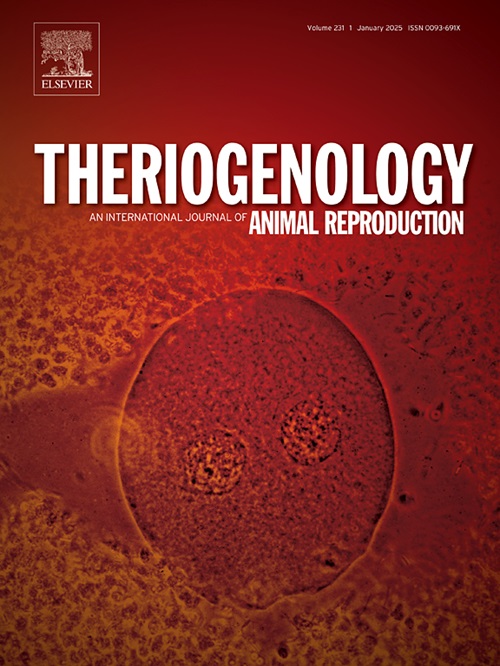hCG对大羊驼黄体发育及血浆黄体酮浓度的影响
IF 2.4
2区 农林科学
Q3 REPRODUCTIVE BIOLOGY
引用次数: 0
摘要
本研究旨在评价促排卵后第3、4、5天注射hCG对大羊驼黄体(CL)功能的影响,进而评价其对妊娠动物的影响。在用buserelin诱导排卵(第0天)后,将羊随机分为hCG3 (n = 5)、hCG4 (n = 5)、hCG5 (n = 5)或对照组(n = 5),分别在第3、4、5天注射750 IU hCG或1.5 ml生理盐水溶液。从第6天至第12天,每隔一天进行一次经直肠多普勒超声检查。从第2天到第8天每天采集血样,每隔一天采集一次,直到第12天。与对照组相比,添加hCG4的大羊驼在第10天血浆P4浓度较高,AUC较高,血浆P4在1 ng ml-1以上的持续时间更长。基于这些结果,进行了研究2。配对后随机分为“治疗组”(n = 10)和“对照组”(n = 10),分别于诱导排卵后第4天注射750 IU hCG或生理盐水。从交配后第6天至第16天,每天进行多普勒超声检查和P4评估采血。妊娠治疗后的血浆P4浓度往往高于未治疗的妊娠母羊。这些结果表明,第4天给药hCG有促黄体作用。本文章由计算机程序翻译,如有差异,请以英文原文为准。
Effect of hCG administration on corpus luteum development and plasma progesterone concentration in llamas
This study aimed to evaluate the effect of hCG injection on Day 3, 4 or 5 post-induction of ovulation on corpus luteum (CL) function in llamas and then, to evaluate its effect on pregnant animals. After induction of ovulation with buserelin (Day 0), llamas were randomly assigned to one of four groups: hCG3 (n = 5), hCG4 (n = 5), hCG5 (n = 5) or control (n = 5), receiving an injection of 750 IU of hCG on Day 3, 4 or 5 or 1.5 ml of saline solution, respectively. All females were examined by transrectal doppler ultrasonography, every other day from Day 6 until Day 12. Blood samples for P4 determination were collected daily from Day 2 to Day 8 and every other day until Day 12. Llamas with hCG4 showed higher plasma P4 concentration on Day 10, higher AUC and plasma P4 remained above 1 ng ml-1 for more days than the control group. Based on these results, Study 2 was performed. Llamas were mated and randomly divided in “Treated” (n = 10) and “Control” (n = 10) group, receiving an injection of 750 IU of hCG or saline solution on Day 4 post-induction of ovulation, respectively. Doppler ultrasonography and blood collection for P4 evaluation were also performed daily, from Day 6 until Day 16 post mating. Plasma P4 concentration post-mating tended to be greater in pregnant treated llamas than in non-treated pregnant females. These results suggest that hCG administration on Day 4 has a luteotropic effect.
求助全文
通过发布文献求助,成功后即可免费获取论文全文。
去求助
来源期刊

Theriogenology
农林科学-生殖生物学
CiteScore
5.50
自引率
14.30%
发文量
387
审稿时长
72 days
期刊介绍:
Theriogenology provides an international forum for researchers, clinicians, and industry professionals in animal reproductive biology. This acclaimed journal publishes articles on a wide range of topics in reproductive and developmental biology, of domestic mammal, avian, and aquatic species as well as wild species which are the object of veterinary care in research or conservation programs.
 求助内容:
求助内容: 应助结果提醒方式:
应助结果提醒方式:


